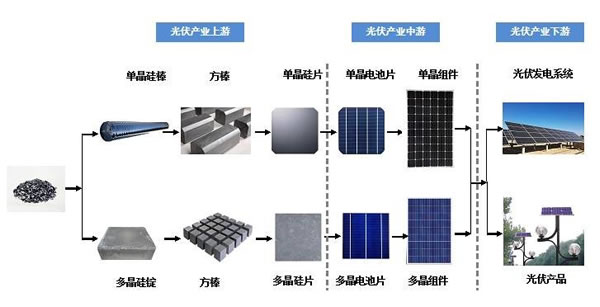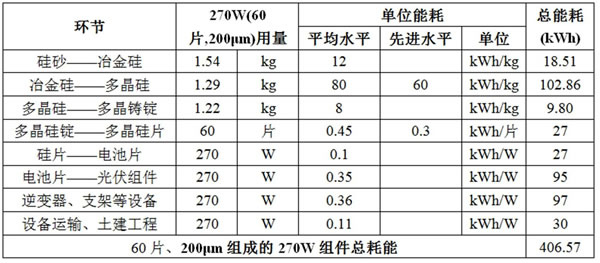1. Production of photovoltaic modules
Monocrystalline silicon components:
Silicon material→single crystal silicon rod→single crystal square rod→single crystal silicon wafer→single crystal cell wafer→single crystal module
Polysilicon components:
Silicon material→Polycrystalline silicon ingot→Polycrystalline square rod→Polycrystalline silicon wafer→Polycrystalline wafer→Polycrystalline module
Specific as shown below

2. The energy consumption of photovoltaic power stations
The following data comes from: China Photovoltaic Industry Association
1) Equipment
Take a 60-chip, 270Wp polysilicon component as an example.

2) Component Accessories
Taking 60 polysilicon components as an example, the weight of glass is 12.93kg, and 350kg of standard coal is consumed per ton of photovoltaic glass, and the equivalent of 0.1229kg of standard coal is calculated at 1kWh. The power consumption of photovoltaic glass is 0.142kWh/W, and the aluminum frame is 2.8kg. The consumption of electricity per ton is 13,35 thousand degrees, the power consumption of aluminum frame is 0.144 kWh/W, and the power consumption of components such as lamination is about 0.06 kWh/W.
3) Power station auxiliary materials
Each 100 MW power station needs 5000t steel brackets, 1,500t steel bars, and 850km of various types of cables. The energy consumption of the steel and steel bars is 0.3kWh/W. The energy consumption of the cables is about 0.01kWh/W, and the step-up transformer and inverter are 0.05kWh. /W calculation.
4) Single Watt Energy Consumption
In summary, the total energy consumption of the 270Wp module is 406.57kWh, and the unit energy consumption is 1.5kWh/W.
3, the energy recovery period of photovoltaic power plant
Take Beijing as an example, Beijing's annual average annual total radiation is 1371kWh/m2; a 1MWp photovoltaic power plant with a fixed angle of 36° distributed photovoltaic project, the annual peak hours is 1628h, considering the 80% system efficiency ,then:
The first year's power generation = 1000kW x 1302.4h x 80% = 1.30 million kWh
Considering 10% attenuation in 10 years and 20% in 25 years, the 25-year average annual power generation is about 1.157 million kWh.
The average annual power generation of 1MWp PV modules is 1.157 million kWh, and the single-watt power generation is 1.157kWh.
The energy recovery period of photovoltaic power plants is:
1.5kWh÷1.157kWh/year=1.3years
Engineering Veneer is a thin sheet of wood, rotary cut, sliced or sawed from expensive natural wood. The Veneer is easy to be edge jointed and overlaid on Plywood , MDF , particleboard and so on. So, it can be used in fancy plywood, fancy MDF, fancy Blockboard and veneer faced Particle board.We have Natural Engineering Veneer and Engineering Fancy Veneer
Luli Group Co., Ltd, also supply engineered wood veneers with good quality and competitive pricing.
Advantages of using veneers:
Compared to wood, one of the primary advantages of using veneer is stability. While solid wood can be prone to warping and splitting, because veneer is made of thin layers of wood glued together, the chances of splitting or cracking are reduced. Further, the glue used provides additional strength, making the end result stronger than natural wood.
Usages of Veneer:
Used to cover the surface of plywood, MDF, chipboard, blockboard and so on.
Specification details:
Sizes: 1220mm x 2440mm, 1250mm x 2500mm or as your request
Thickness: From 0.15mm to 0.6mm or as per request
Species: Okoume, Bintangor, Terminalia, Red hardwood, etc.
Grade available: A/A, A/B, B/B
Cutting way: Rotary cutting
Engineering Veneer
Engineering Veneer,Natural Engineering Veneer,Engineering Fancy Veneer,Engineered Wood Veneer
Luli Group Co.,Ltd. , https://www.cnluli.com
![<?echo $_SERVER['SERVER_NAME'];?>](/template/twentyseventeen/skin/images/header.jpg)